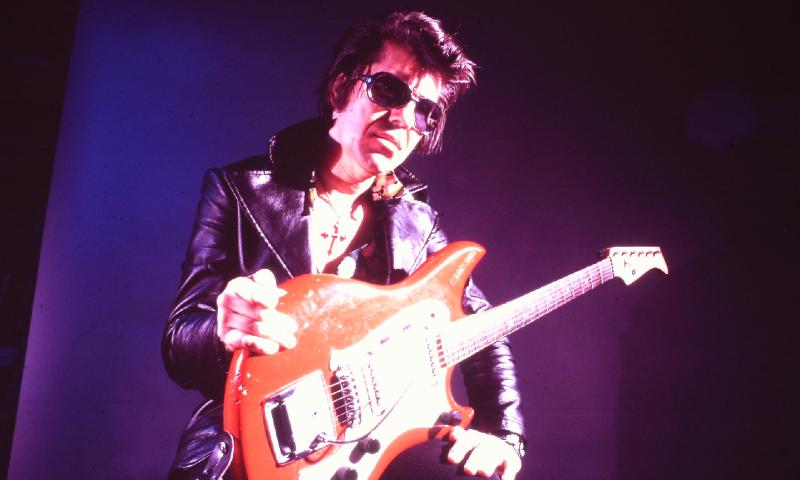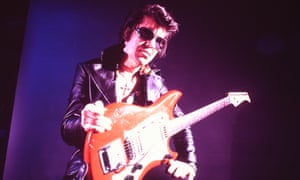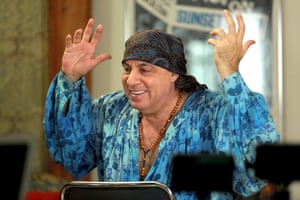Rumble: the story of the Native Americans who shaped rock music - Native American Heritage Month


In an eye-opening new documentary, hidden Native American figures are finally given credit for influencing a vast amount of popular music

Link Wray. Photograph: Bruce Steinberg
F or a song with no lyrics, Rumble managed to say a lot about sex, swagger and the allure of teenage rebellion. Released in 1958 by Native American guitarist Link Wray, the track – all dirty chord progressions and blistering guitar – was an omen of the impending 60s rock revolution, and is widely credited with inventing the power chord that would become essential to rock, metal, thrash and other tangential genres. Sixty-one years after its release, Rumble remains the only instrumental track to be banned from American radio, for fear it would incite youth violence
But this wordless call to arms did get through to the masses, and certain members of the audience to which it spoke would internalize Rumble’s sound and spirit and with them create a new and fantastically unholy genre of larger than life guitar music.
“Jeff Beck told me that he and Jimmy Page used to jump around the bedroom at his mom’s house playing air guitar to Link Wray,” says guitarist Stevie Salas. “To visualize these guys that are like, the Mount Rushmore of rock stars playing air guitar to a Shawnee Indian, it just blew my mind.”
Indeed, Link Wray, the leather-clad rocker prowling the stage with mega-bravado, grew up poor in rural South Carolina in the days when the Ku Klux Klan would ride by his house in the middle of the night, and when the Klan was just as likely to come after you for being Indian as for being black. He’s one of many Native artists – Jimi Hendrix, The Band’s Robbie Robertson, jazz vocal icon Mildred Bailey – whose heritage was largely hidden, even as they shaped musical history.
Wray’s most famous song thus serves as the title of Rumble: The Indians Who Rocked the World, a documentary exploring the Native American presence in, and influence on, popular music. Released last year, Rumble makes its US television premiere on 21 January and in it, Steve Van Zandt calls Rumble “the soundtrack to juvenile delinquency” while Iggy Pop preaches that the track “ did help me say ‘fuck it, I’m gonna be a musician.’”
But Rumble’s narrative goes far deeper than teenage impulses, tracing a path from rock ‘n’ roll to jazz to the blues to the music of pre-colonial America, before European immigrants and Federal government began their systematic decimation of Native people and the vibrant musical traditions they carried. Through exhaustive research backed by the Smithsonian, Rumble makes a case that the blues, the oldest form of American popular music, was influenced by even more ancient Native styles of playing and singing.
In particular, the film points to Charley Patton – “the father of the Delta blues” who are believed to have Choctaw ancestry – as a key artist who melded traditional tribal rhythms with the then-burgeoning blues. The scene in which Tuscarora/Taíno musician Pura Fé demonstrates the Native influence in Patton’s Down the Red Dirt Road will likely give you chills.
“That’s Indian music with a guitar,” Fé says, her eyes lighting up, “that’s where it went.”
Patton’s style influenced other blues artists and, eventually, the British rock and rollers like The Rolling Stones, The Who, and Zeppelin who would bow at their feet in the ‘60s. Rumble features a 1965 clip from the American musical variety show Shindig! in which the Stones host a performance by Howlin’ Wolf, who was deeply influenced by Patton. With such footage, Rumble fleshes out the DNA of popular music, which has for centuries been incomplete due to the suppression of Native people.
“As we started to find out the depth of it, we were so excited and also felt a tremendous amount of responsibility to do it properly,” says Rumble’s director Catherine Bainbridge. “It’s a nuanced thing, and it’s not about over-claiming anything. It’s just about saying there’s a part of that history that got buried, and that you should know because it was important.”
Rumble took four years to make and was filmed in 28 cities throughout North America – from the deep south to the mountainous west – with the film-makers often spending days with families of the musicians they were investigating, gathering stories and digging through old photo albums.

Steven Van Zandt Photograph: Pedro Ruiz/Rezolution Pictures
Ultimately, they gathered over 10,000 pieces of archival materials and did 178 hours worth of interviews with musicologists, historians, journalists, poets and rockstars. Rumble’s cast features Pop, Van Zandt, George Clinton, Martin Scorsese, Steven Tyler, Dan Auerbach, Taj Mahal, Jackson Browne, Slash, Buffy Sainte-Marie, Robbie Robertson, Metallica’s Robert Trujillo, Wayne Kramer of the MC5, Taboo of the Black Eyed Peas and other musical luminaries talking about each artist in question with unmistakable deference.
“I was completely influenced by Mildred Bailey,” Tony Bennett gushes. “She sang perfect, for me.”
The A-list cast was largely a function of the film’s executive producer Stevie Salas, a venerable rock guitarist who’s toured with Rod Stewart and The Rolling Stones. Salas and Bainbridge felt it was key to have famous musicians proclaiming the importance of Native artists in order to make the case for their importance and add weight to interviews with subjects including Fè and the late Santee Dakota author, musician and activist John Trudell.
“To me it was important that it wasn’t just Native people praising these musicians, but the biggest rockstars in the world,” Salas says. “If I got on screen and said, ‘Jesse Ed Davis was the greatest guitar player,’ you’d say, ‘Okay, whatever.’ If Eric Clapton tells you, you’re a lot more inclined to believe him.” Salas’ rock Rolodex also helped open doors when requesting interviews.
“Everyone,” says Bainbridge, “said yes without hesitation”.
The idea for Rumble came to Salas after he worked he worked with co-Executive Producer Tim Johnson at the Smithsonian Museum of the American Indian on Up Where We Belong: Native Musicians In Popular Culture. Based on Brian Wright-McLeod’s 2000 book The Encyclopedia of Native Music, this 2010 exhibition displayed artifacts from Native musicians including Jimi Hendrix, Robertson and Sainte-Marie, and hosted record crowds in Washington D.C. and New York. In this era, Salas was spending time on reservations and had witnessed he says, “what seemed to be a lack of role models. People to look up to Native Americans from 100 or 200 years ago, the Sitting Bulls and Geronimos. I wanted to do something to show Native American people that Native American musicians were really influential and fantastic.” He decided to make the exhibit into a movie.
Collaborating with Bainbridge was an easy fit, as the Canadian director had made the 2009 film Reel Injun, which documented Hollywood’s portrayals, and misportrayals, of Native people. What the filmmakers and their team found as they researched was, to them, nothing less than a revision of history, so much so that a curriculum has been developed around Rumble so it can be taught in schools. Meanwhile, last year Rumble found wide release in hundreds of theaters throughout North American and Europe. (Of using the controversial label “Indian” in the title, Salas says: “The goal was to get as many people to understand what the film is, so they’d see it and learn the information. If that meant using a word people are more familiar with, the end justified the means.”)
In 2017, Rumble was named one of the year’s best Canadian films at the Toronto film festival and won the world cinema documentary special jury award for masterful storytelling at the Sundance film festival. Salas couldn’t attend Sundance, as he was on tour in Japan recouping some of the money he lost while taking time off the road to make the movie. Meanwhile Bainbridge and her husband, who is First Nation, had mortgaged their house to help finance the film.
For the duo, the steep investment of time and money has paying off not only in praise, but more so in the opportunity to shine a light on Native American heroes who, until now, have been largely left out of the mainstream.
“What makes me so proud about the film,” Bainbridge says, “is that now all of us can know this history, and once we know that, we know there are other things we don’t know. That’s where we are right now in our history of decolonization—all the stories are being retold.”



Go to the seeded article to view the trailer (video) well worth watching.
One of my favorite bands is ''The Band'' with Robbie Robertson, Mohawk.
The Weight..
Link Wray, Rumble.
Robbie Robertson and the Band, for sure. I had the privilege of seeing them performing with Rompin' Ronnie Hawkins in the bars on Toronto's Yonge Street. And I've seen videos of Rumble here - he moved the goalposts.
I've always liked Quicksilver Messenger Service. Gary Duncan Singer-/Guitarist is an Indian.
Good choice Dean.
I saw him and Quick Silver a couple of times when I lived in the bay area.
Sadly, Gary walked on a couple of months ago..
A couple of other Native groups that I enjoyed in that time period were XIT and Red Bone.
Here is a group, Nightwish with John Two Hawks that you might enjoy. Quite different actually.
Creek Mary's Blood.
Ulali - three extremely talented Native American women - Pura Fé (Tuscarora/Taino), Soni (Mayan, Apache, Yaqui), and Jennifer Kreisberg (Tuscarora). Ulali's sound encompasses an array of indigenous music including Southeast United States choral singing (pre-blues and gospel) and pre-Columbian music. Ulali's live performances address Native struggles and accomplishments.
Their first album was in the Occonechi language, translated by two very good friends - John Jeffries Blackfeather and Lawrence Dunmore - both of the Occonechi tribe and both processed and hounded the NC legislature to finally recognize the Occonechi tribe as a State Recognized Tribe.
I saw them in Hawaii a few years back, actually around 10 years ago. Time flies.